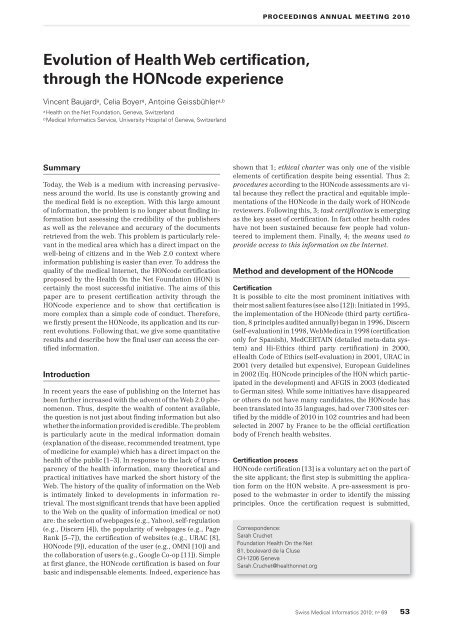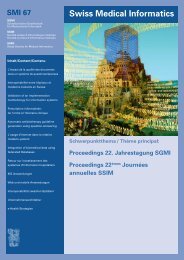Swiss Medical Informatics SMI 69 - SGMI
Swiss Medical Informatics SMI 69 - SGMI
Swiss Medical Informatics SMI 69 - SGMI
Sie wollen auch ein ePaper? Erhöhen Sie die Reichweite Ihrer Titel.
YUMPU macht aus Druck-PDFs automatisch weboptimierte ePaper, die Google liebt.
Evolution ofHealth Web certification,<br />
through the HONcode experience<br />
Vincent Baujard a ,Celia Boyer a ,Antoine Geissbühler a,b<br />
a Health on the Net Foundation, Geneva, Switzerland<br />
b <strong>Medical</strong> <strong>Informatics</strong> Service, University Hospital of Geneva, Switzerland<br />
Summary<br />
Today, the Web isamedium with increasing pervasiveness<br />
around the world. Its use is constantly growing and<br />
the medical field is no exception. With this large amount<br />
of information, the problem is no longer about finding information<br />
but assessing the credibility of the publishers<br />
as well as the relevance and accuracy of the documents<br />
retrieved from the web. This problem is particularly relevant<br />
inthe medical area which has adirect impact on the<br />
well-being ofcitizens and inthe Web 2.0 context where<br />
information publishing iseasier than ever. Toaddress the<br />
quality of the medical Internet, the HONcode certification<br />
proposed by the Health On the Net Foundation (HON) is<br />
certainly the most successful initiative. The aims of this<br />
paper are to present certification activity through the<br />
HONcode experience and to show that certification is<br />
more complex than asimple code of conduct. Therefore,<br />
we firstly presentthe HONcode, its application and its currentevolutions.<br />
Following that, we give some quantitative<br />
resultsand describe how the final user can access the certified<br />
information.<br />
Introduction<br />
In recent years the ease of publishing on the Internet has<br />
been further increased with the advent of the Web2.0 phenomenon.<br />
Thus, despite the wealth of content available,<br />
the question is not just about finding information but also<br />
whether the information provided is credible. The problem<br />
is particularly acute in the medical information domain<br />
(explanation of the disease, recommended treatment, type<br />
of medicine for example) which has adirect impact on the<br />
health of the public [1–3]. In response to the lack of transparency<br />
of the health information, many theoretical and<br />
practical initiatives have marked the short history ofthe<br />
Web. The history of the quality of information onthe Web<br />
is intimately linked todevelopments in information retrieval.<br />
The most significant trendsthat have been applied<br />
to the Web onthe quality of information (medical or not)<br />
are: the selection of webpages (e.g.,Yahoo), self-regulation<br />
(e.g., Discern [4]), the popularity of webpages (e.g., Page<br />
Rank [5–7]), the certification of websites (e.g., URAC [8],<br />
HONcode [9]), education ofthe user (e.g., OMNI [10]) and<br />
thecollaboration of users(e.g., Google Co-op [11]). Simple<br />
at first glance, the HONcode certification is based on four<br />
basicand indispensable elements. Indeed, experience has<br />
PROCEEDINGS ANNUAL MEETING 2010<br />
shown that 1; ethical charter was only one ofthe visible<br />
elements of certification despite being essential. Thus 2;<br />
procedures according to theHONcodeassessments are vital<br />
because they reflect the practical and equitable implementations<br />
of the HONcode in the daily work ofHONcode<br />
reviewers. Following this, 3; taskcertification is emerging<br />
as the key asset of certification. In fact other health codes<br />
have not been sustained because few people had volunteered<br />
to implement them. Finally, 4;the means used to<br />
provide access to this information on the Internet.<br />
Method and development of the HONcode<br />
Certification<br />
It is possible tocite the most prominent initiatives with<br />
their most salient features (see also [12]): Initiated in 1995,<br />
the implementation of the HONcode (third party certification,<br />
8principles audited annually) beganin1996, Discern<br />
(self-evaluation) in 1998, WebMedica in 1998 (certification<br />
only for Spanish), MedCERTAIN (detailed meta-data system)<br />
and Hi-Ethics (third party certification) in 2000,<br />
eHealth Code ofEthics (self-evaluation) in 2001, URAC in<br />
2001 (very detailed but expensive), European Guidelines<br />
in 2002 (Eq. HONcode principles of theHON which participated<br />
in the development) and AFGIS in2003 (dedicated<br />
to German sites).While some initiatives have disappeared<br />
or others do not have many candidates, the HONcode has<br />
been translated into 35 languages, had over 7300 sites certified<br />
by the middle of 2010 in 102 countries and had been<br />
selected in 2007 by France to be the official certification<br />
body ofFrench health websites.<br />
Certification process<br />
HONcode certification [13]isavoluntaryact on thepart of<br />
the site applicant; the first step is submitting the application<br />
form onthe HON website. Apre-assessment is proposed<br />
to the webmaster in order to identify the missing<br />
principles. Once the certification request is submitted,<br />
Correspondence:<br />
Sarah Cruchet<br />
Foundation Health On the Net<br />
81, boulevard de la Cluse<br />
CH-1206 Geneva<br />
Sarah.Cruchet@healthonnet.org<br />
<strong>Swiss</strong> <strong>Medical</strong> <strong>Informatics</strong> 2010; n o <strong>69</strong><br />
53



